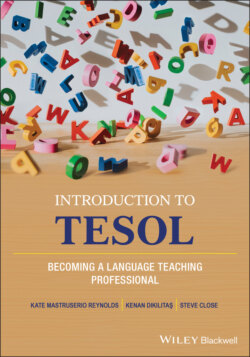Читать книгу Introduction to TESOL - Kate Reynolds - Страница 71
Advocacy about ELLs and academic learning
ОглавлениеOther pervasive myths that affect ELLs and which TESOL professionals strive to clarify and remedy through advocacy and research are (a) instruction strategies for including ELLs in general education courses is simply good teaching, and (b) ELLs can acquire English in 1–2 years of study. First, appropriate inclusive instruction for ELLs recognizes the language demands and expectations of learning both social and academic language. Social language is the oral and written language we use to establish, maintain, and conclude interpersonal relationships. For example, we may greet someone in passing in the office by saying, “Hey! How are you? Haven’t seen you around in a while.” Alternatively, you could say, “Long time, no see.” At a library, we might inquire about the availability of a book by saying to the librarian, “Hi. I’m looking for the book, A Tale of Two Cities, by Dickens. When will it be back?” Social language can be speaking to someone in person, on the phone, or texting with abbreviations and emojis. According to Cummins’ (1979) research, it takes 1–3 years to acquire social language.
Cummins distinguished social from academic language. Academic language is the language we use to engage with academic learning. For example, in history classes, books, and documentaries, one hears and reads many descriptions of historical time periods, such as the feudal period. The lives of the wealthy elites, the crafts people, and the agricultural laborers would be described. For historical descriptions, we need to know many adjective forms, past tense verbs, among other language. Science fields have descriptive language as well. For instance, they may describe different attributes of animals or plants. The language demands for academic learning can be subject specific and cognitively demanding; therefore, Cummins indicated that it takes between 5 and 7 years to acquire academic language. It could take up to 10 years, if the learning was interrupted by moving from place to place or other events that caused them to change schools or be away from school for a period of time. TESOL educators have advocated so strongly on these topics that general educators now take teacher preparation courses on working with ELLs and the concepts have permeated the standards of various disciplines.
